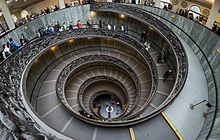Bramante Staircase
 From Wikipedia - Reading time: 7 min
From Wikipedia - Reading time: 7 min
| Bramante Staircase | |
|---|---|
 The "Momo", modern evolution of 'Bramante' spiral stairs of 1932. | |
 Click on the map for a fullscreen view | |
| Location | Vatican Museums |
| 41°54′23″N 12°27′16″E / 41.9064°N 12.4544°E | |
Bramante Staircase is the name given to two staircases in the Vatican Museums in the Vatican City State: the original stair, built in 1505, and a modern equivalent from 1932.
The original staircase
[edit]
The original Bramante staircase, in the Pio-Clementine Museum, was built in 1505 to a double helix design by Donato Bramante. It connects the Belvedere palace of Pope Innocent VIII to the outside and stands in a square tower of that building.[1]
The Bramante Staircase features granite Doric columns and a herringbone paving pattern, and was designed to allow people and pack animals to ascend and descend without interruption.[1] The stair is cited as the inspiration for Antonio da Sangallo the Younger's design for the double helix passageway at the well of San Patrizio in Orvieto, to solve a similar logistical problem. The staircase was built to allow Pope Julius II to enter his private residence while still in his carriage, since walking up the several flights in heavy papal vestments would have been onerous.[citation needed]
It is not generally open to the public, though specialist tours do visit.[1]
The modern staircase
[edit]
The modern double helix staircase, also in the Pio-Clementine Museum, and commonly referred to as the "Bramante Staircase", was designed by Giuseppe Momo, sculpted by Antonio Maraini and realized by the Ferdinando Marinelli Artistic Foundry in 1932 and was inspired by the original Bramante Staircase. This staircase, like the original, is a double helix, having two staircases allowing people to ascend without meeting people descending; as with the original, the main purpose of this design is to allow uninterrupted traffic in each direction. It encircles the outer wall of a stairwell approximately fifteen meters wide and with a clear space at the centre. The balustrade around the ramp is of ornately worked metal. A canopy located above provides the necessary light to illuminate the stairs. The staircase is located at the end of the museum visit and all visitors leave by this route.[2]
Several architecture professors have speculated that Momo’s staircase (particularly the skylight and atrium, and the helical nature of the ramp and the technical aspects of its construction) was the inspiration for Frank Lloyd Wright’s design for the Solomon R. Guggenheim Museum in New York.[3][4][5]
See also
[edit]References
[edit]- ^ a b c Bramante Staircase at insightvacations.com Retrieved 23 August 2015
- ^ Bramante staircase at photovoyage.org (in French)
- ^ Tanzj, Daniela; Bentivegna, Andrea (July 23, 2015). "The Vatican Museums and the Guggenheim: Two Ingenious Spirals of Art". La Voce di New York.
- ^ Hersey, George L. (1993). High Renaissance art in St. Peter's and the Vatican: an interpretative guide. Chicago: University of Chicago Press. p. 128. ISBN 9780226327822.
- ^ Mindel, Lee F. (February 28, 2013). "Compares the Oculi at the Vatican and the Guggenheim Museum". Architectural Digest.
 KSF
KSF